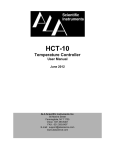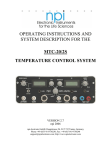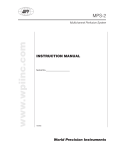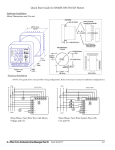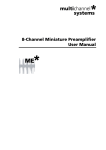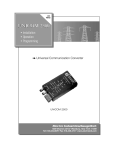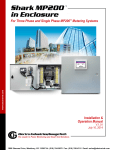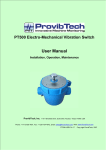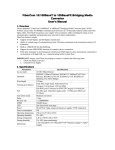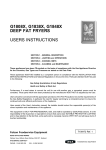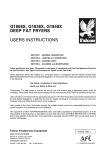Download QMM Micromanifold - ALA Scientific Instruments
Transcript
QMM Micromanifold User Manual ALA Scientific Instruments 1100 Shames Drive Westbury, NY 11590 Tel: 516-997-5780 Fax: 516-997-0528 Email: [email protected] www: http://www.alascience.com ® Introduction The quartz micromanifold® consists of anywhere from 1-14 tubes. Usually they are about 100µm ID. A single 200µm tube is added to act as a reverse flow tube in order to suck the dead volume of the manifold clear or provide an input wash for the same purpose. All specifications as to the number of tubes must be specified at the time of ordering. The standard configuration of a QMM is (a) 100µm ID tubes for solution delivery, (b) one 200µm tube for flushing the (c) dead space and a 100µm tip (approx. 5mm long). The tip (front part) of the manifold is removable. (a) The output tube ID is usually 100µm but other sizes are available. The large part of it is composed of silicon tubing which forms a tight seal over the multi tube cluster. (c) The gap (dead space) in the manifold can be adjusted by sliding the silicon up or down on the cluster. The dead space can be calculated by using an equation to determine the area of the conical section where the base is about 1mm, the top is about 250µm and the length is the size of the gap. Dead volumes are usually less than 1µl and typically between 50 and 100 nl. Additional dead volume comes from the length of the single outlet tube. Its volume can be calculated by using the formula for the area of a cylinder with a diameter of 100µm and a length of however long it is cut. (It may be cut as short as is needed—after cutting the tip should be polished using 600 grade sandpaper only. Cut with wire cutters and always shield eyes.) Tubes are made of quartz glass coated with polyamide. They are rather flexible and durable. The tip should not break even if bumped repeatedly against the bottom of a petri dish. Tubes are held together with a cyanoacrylite glue. The quartz glass is very durable and somewhat slippery to a variety of solutions including those containing proteins and lipids. Clogging should not be a problem but care should be taken to be sure that filtered solutions are used. If a tube should become clogged it can be blown out with air/liquid pressure. The quartz tubes can withstand pressures of several thousand PSI. 1 Be sure not to compress the tip too far over the cluster so that it blocks some of the tubes. If you do not get flow, pull the tip off slightly and try again. Under normal use, solutions should flow through the manifold under gravitational force. A height of ½ meter is adequate. Adding additional pressure of just a few PSI (10-20 kPa) will increase flow significantly. Flow rates will be affected by the length and diameter of the feed tubes. Remove all air bubbles from feed tubes as they cause irritating compliance with regard to flow. 2 For those who wish to use the ALA FEP tubing (Teflon (Dupont)) see below for ordering information or we recommend PE-10 tubing (Polyethylene) for all connections. Each tube of the Micromanifold has a piece of Silicone tubing attached to act as a link to other tubes. The Silicone tube permits the use of various sizes of tubing to be used with the Micromanifold without the necessity to get an exact match. The silicone tube is glued to the quartz tubes with a cyanoacrylite glue (“Crazy Glue” or “Super Glue”). Should one come off it should be reattached with a similar product. In order to insert a tube into the silicone you may first have to expand the tube slightly with the insertion of a large pin or other sharp object. Always cut a straight, square end on any tube to be inserted into a silicone tube or connector where possible. Otherwise a beveled edge is easier to insert although it may present clogging problems, so perhaps a compromise angle cut is best. The inside diameter of the silicon connectors provided is about 100µm. Should this be smaller than the inside diameter of the tubing you are using to connect to the Quartz Micromanifold®, you may wish to remove the silicone connectors, or use them to seal over the connecting tubing. For example if the tubing you use has a larger ID than the OD of the quartz capillaries, then the tubing can be placed over the capillaries, but the connection will be leaky. In this case the silicone connectors can be slipped over the interface of the tubing/quartz capillary to form a seal. When silicone connectors are glued in place (on 100µm ID tubing), they may be removed with a small amount of acetone at the glue spot. Be sure to remove all glue residue carefully so as not to clog the capillary. Keep acetone away from the front end of the Micromanifold®. If your tubing forms a tight seal with the Quartz capillary, then there is no need to use the silicone connector. Quartz tubes of 100µm ID can sometimes be mated to PE-10 tubing (Polyethylene Tubing #10 Clay Adams Co., now a division of Baxter) which is available from Thomas Scientific through their catalog. Teflon tubing and silicone connectors are available from ALA or your distributor. 200µm ID tubing can usually be mated to PE-20 (also available from the above sources). Daily Maintenance At the end of each day you may wish to flush out the tubes of the Micromanifold®. Some may want to disinfect these parts as well. You can use any bacteriacide you wish. Just do not use strong acids, strong bases or acetone. To flush out each tube of the QMM, attach a syringe (10ml) containing a flush solution to each tube and pushing the solution through the QMM and out the tip. It is a good idea to keep the tip of the Micromanifold® submerged to prevent it from drying out. The same would apply to the rest of the cluster if the tip was removed. If you blow out all lines with air, the above is not necessary. If a tube should become clogged follow the cleaning procedure in the next section. 3 Micromanifold Cleaning Procedure The Micromanifold® should never be heat sterilized but can be autoclaved to 120oC. If a tube should become clogged it should be isolated and distilled water should be worked in with a syringe under pressure to free it up. The same method should be used for the tip if it becomes clogged. To find a clog: 1. Remove the tip, 2. Determine that all the tubes on the QMM flow with the tip removed. This is accomplished by attaching an empty syringe (10ml) to each tube on the QMM, placing the output of the QMM in water and applying pressure to the syringe. You should see air bubbles coming out of the QMM output. Repeat this for each tube including the tip. 3. If there is no air bubbles coming out of any one of the tubes then that tube is clogged. To unclog a tube: 1. Use a syringe (10ml) filled with a flush solution, such as distilled water or isopropyl alcohol, and attach it to the clogged tube. 2. Place the output of the QMM in a container filled with the flush solution. 3. Push the flush solution through the tube. If the flush solution does not flow through the tube, push and withdraw the syringe repeatedly until the clog is broken. 4. Repeat for each clogged tube. Note: If the QMM tube can not be unclogged using the procedure above, you can try the following steps: 1. Place the QMM in an ultrasonic cleaner. Repeat unclogging procedure. 2. In unclogging procedure use boiling water to soak the QMM while applying pressure on the syringe. 4





